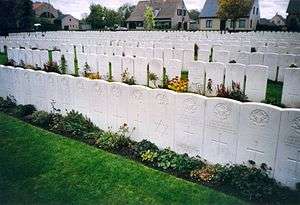Duhallow ADS Commonwealth War Graves Commission Cemetery
Duhallow ADS (Advanced Dressing Station) Cemetery is a Commonwealth War Graves Commission burial ground for the dead of the First World War located near Ypres on the Western Front in Belgium.
| Duhallow ADS | |
|---|---|
| Commonwealth War Graves Commission | |
 | |
| Used for those deceased 1917–1918 | |
| Established | July 1917 |
| Location | 50°51′51″N 02°52′39″E near |
| Designed by | Sir Reginald Blomfield |
| Total burials | 1602 |
Unknowns | 234 |
| Burials by nation | |
Allied Powers:
| |
| Burials by war | |
World War I: 1601
World War II: 1 | |
| Statistics source: WW1Cemeteries.com | |
The cemetery grounds were assigned to the United Kingdom in perpetuity by King Albert I of Belgium in recognition of the sacrifices made by the British Empire in the defence and liberation of Belgium during the war.[1]
Foundation
"Duhallow" is believed to be derived from a south Ireland hunt name.[2] The position, north of Ypres, was used as an Advanced Dressing Station (a first aid post set back from the main front but within easy reach of it) for Commonwealth troops in the area. This led to the establishment of the cemetery for those who did not survive; this cemetery was expanded by the addition of the dead from nearby Casualty Clearing Stations at the front line itself.[3]
Additionally, there are graves for the men of the 13th Company Labour Corps who were killed by a German aircraft bombing a Commonwealth ammunition truck.[4]
The cemetery was further expanded after the armistice by the concentration of isolated graves. Stones in the cemetery commemorate the men buried in the nearby Malakoff Farm and Fusilier Wood cemeteries, which were destroyed by shelling.[2]
The cemetery was designed by Sir Reginald Blomfield.
Notable graves
The cemetery contains the graves of 1602 soldiers. Amongst those are the graves of one World War II Commonwealth casualty, killed during the retreat in May 1940.
Also buried here is Private 10603 John Seymour of the 2nd Battalion of the Royal Inniskilling Fusiliers,[5] who was executed by the British authorities on 24 January 1918 for being absent from roll call on 27 November 1917. He was known to suffer from "nerves" and was executed partially to set an example to his battalion's 300 new recruits.[6]
Gallery
 Special memorial for troops whose graves were destroyed in later battles.
Special memorial for troops whose graves were destroyed in later battles. Duhallow ADS, including a Belgian grave.
Duhallow ADS, including a Belgian grave. Duhallow ADS, including three of the 54 German graves.
Duhallow ADS, including three of the 54 German graves.
References
- "Soldatenfriedhof: Vladslo". Webmatters.net. 1914-10-23. Retrieved 2014-04-12.
- Reading Room Manchester. "Cemetery Details". CWGC. Retrieved 2014-04-12.
- Archived September 4, 2004, at the Wayback Machine
- "Duhallow A.D.S Cemetery". Ww1cemeteries.com. Archived from the original on 2014-04-13. Retrieved 2014-04-12.
- Commonwealth War Graves Commission Casualty record for Private Seymour, accessed 19 August 2006
- "Report into the Courts-Martial and Execution of Twenty-Six Irish Soldiers by the British Army During World War I". Shotatdawn.org. 14 November 2003. Archived from the original on 4 October 2006. Retrieved 19 August 2006.
External links
| Wikimedia Commons has media related to Duhallow A.D.S. Cemetery. |
- Cemetery details. Commonwealth War Graves Commission.
- wo1.be Non-Commonwealth burials in Duhallow
- Duhallow ADS Cemetery at Find a Grave